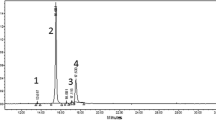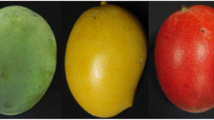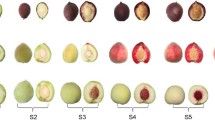Abstract
To identify the key enzymes involved in anthocyanin synthesis in sweet cherry (Prunus avium L.), the differences in anthocyanin biosynthetic gene expressions were investigated in the samples (mix of peel and flesh) of a red-colored cultivar (‘Hongdeng’) and a bicolored cultivar (‘Caihong’) during fruit development. The expression of six anthocyanin synthetic genes in cherry (PacCHS, PacCHI, PacF3H, PacDFR, PacANS, and PacUFGT) was analyzed by quantitative real-time PCR and Western blot analysis. Meanwhile, the changes in anthocyanin contents were measured by ultra-performance liquid chromatography. The expression of anthocyanin synthetic genes and the anthocyanin contents were much higher in ‘Hongdeng’ than in ‘Caihong’ fruits. Gene transcription and translation and anthocyanin accumulation all started approximately at the end of the pit-hardening period and reached a maximum at maturation. All six genes were significantly correlated with anthocyanin accumulation in ‘Hongdeng’ and PacCHS had the highest direct effect. However, only PacUFGT was significantly correlated with anthocyanin accumulation in ‘Caihong’. Anthocyanin biosynthesis in sweet cherry seems to be regulated mostly at the transcript levels. CHS appears to be the key enzyme involved in anthocyanin synthesis in ‘Hongdeng’, while UFGT is involved in anthocyanin synthesis in ‘Caihong’ fruits.



Similar content being viewed by others
References
Boss PK, Davies C, Robinson SP (1996) Expression of anthocyanin biosynthesis pathway genes in red and white grapes. Plant Mol Biol 32:565–569
Castellarin SD, Gaspero GD, Marconi R, Nonis A, Peterlunger E, Paillard S, Adam-Blondon A, Testolin R (2006) Colour variation in red grapevines (Vitis vinifera L.): genomic organisation, expression of flavonoid 3′-hydroxylase, flavonoid 3′,5′-hydroxylase genes and related metabolite profiling of red cyanidin-/blue delphinidin-based anthocyanins in berry skin. BMC Genomics 7:12–29
Charrier B, Coronado C, Kondorosi A, Ratet P (1995) Molecular characterization and expression of alfalfa (Medicago sativa L.) flavanone-3-hydroxylase and dihydroflavonol-4-reductase encoding genes. Plant Mol Biol 29:773–786
DeJong TM, Grossman YL (1995) Quantifying sink and source limitations on dry matter partitioning to fruit growth in peach trees. Physiol Plantarum 95:437–443
Dewey JR, Lu KH (1959) A correlation and path coefficient analysis components of crested wheat grass seed production. Agron J 51:515–518
Espley RV, Hellens RP, Putterill J, Stevenson DE, Kutty-Ammal S, Allan AC (2007) Red colouration in apple fruit is due to the activity of the MYB transcription factor, MdMYB10. Plant J 49:414–427
Feng S, Wang Y, Yang S, Xu Y, Chen X (2010) Anthocyanin biosynthesis in pears is regulated by a R2R3-MYB transcription factor PyMYB10. Planta 232:245–255
Fukusaki E, Kawasaki K, Kajiyama S, Ana C, Suzuki K, Tanaka Y, Kobayashi A (2004) Flower color modulations of Torenia hybrida by downregulation of chalcone synthase genes with RNA interference. J Biotechnol 111:229–240
Gronbaek M, Deis A, Sorensen TIA, Becker U, Schnohr P, Jensen G (1995) Mortality associated with moderate intakes of wine, beer or spirits. Br Med J 310:1165
Guendez R, Kallithraka S, Makris DP, Kefalas P (2005) Determination of low molecular weight polyphenolic constituents in grape (Vitis vinifera sp.) seed extracts: correlation with antiradical activity. Food Chem 89:1–9
Isla MI, Vattuone MA, Sampietro AR (1998) Essential group at the active site of Trapaeolum invertase. Phytochemistry 47:1189–1193
Jaakola L, Määttä K, Pirttilä AM, Törrönen R, Kärenlampi S, Hohtola A (2002) Expression of genes involved in anthocyanin biosynthesis in relation to anthocyanin, proanthocyanidin, and flavonol levels during bilberry fruit development. Plant Physiol 130:729–739
Kim SH, Lee JR, Hong ST, Yoo YK, An G, Kim SR (2003) Molecular cloning and analysis of anthocyanin biosynthesis genes preferentially expressed in apple skin. Plant Sci 165:403–413
Kim DO, Heo HJ, Kim YJ, Yang HS, Lee CY (2005) Sweet and sour cherry phenolics and their protective effects on neuronal cells. J Agric Food Chem 53:9921–9927
Knekt P, Jarvinen R, Seppanen R, Heliovaara M, Teppo L, Pukkala E, Aromaa A (1997) Dietary flavonoids and the risk of lung cancer and other malignant neoplasms. Am J Epidemiol 146:223–230
Laemmli UK (1970) Cleavage of structural proteins during the assembly of the head of bacteriophage T4. Nature 227:680–685
Li F, Jin Z, Qu W, Zhao D, Ma F (2006) Cloning of a cDNA encoding the Saussurea medusa chalcone isomerase and its expression in transgenic tobacco. Plant Physiol Biochem 44:455–461
Liu Y, Liu X, Zhong F, Tian R, Zhang K, Zhang X, Li T (2011) Comparative study of phenolic compounds and antioxidant activity in different species of cherries. J Food Sci 4:C633–C638
Mano H, Ogasawara F, Sato K, Higo H, Minobe Y (2007) Isolation of a regulatory gene of anthocyanin biosynthesis in tuberous roots of purple-fleshed sweet potato [OA]. Plant Physiol 143:1252–1268
Mori K, Sugaya S, Gemma H (2005) Decreased anthocyanin biosynthesis in grape berries grown under elevated night temperature condition. Sci Hortic 105:319–330
Nhukarume L, Chikwambi Z, Muchuweti M, Chipurura B (2010) Phenolic content and antioxidant capacities of Parinari curatelifolia, Strychnos spinosa and Adansonia digitata. J Food Biochem 34:207–221
Sadeghi A, Cheghamirza K, Dorri HR (2011) The study of morpho-agronomic traits relationship in common bean (Phaseolus vulgaris L.). Biharean Biol 5(2):102–108
Sidramappa S, Patil SA, Ssalimath PM, Kajjidoni ST (2008) Direct and indirect effects of phenological traits on productivity in recombinant inbred lines population of chickpea. Karnataka J Agric Sci 21:491–493
Takos AM, Jaffé FW, Jacob SR, Bogs J, Robinson SP, Walker AR (2006) Light-induced expression of a MYB gene regulates anthocyanin biosynthesis in red apples. Plant Physiol 142:1216–1232
Tanaka Y, Sasaki N, Ohmiya A (2008) Biosynthesis of plant pigments: anthocyanins, betalains and carotenoids. Plant J 54:733–749
Usenik V, Fabčič J, Štampar F (2008) Sugars, organic acids, phenolic composition and antioxidant activity of sweet cherry (Prunus avium L.). Food Chem 107:185–192
Wan CY, Wilkins TA (1994) A modified hot borate method significantly enhances the yield of high-quality RNA from cotton (Gossypium hirsutum L.). Anal Biochem 223:7–12
Wang KL, Bolitho K, Grafton K, Kortstee A, Karunairetnam S, McGhie TK, Espley RV, Hellens RP, Allan AC (2010a) An R2R3 MYB transcription factor associated with regulation of the anthocyanin biosynthetic pathway in Rosaceae. BMC Plant Biol 10:2–17
Wang H, Wang W, Zhang P, Pan Q, Zhan J, Huang W (2010b) Gene transcript accumulation, tissue and subcellular localization of anthocyanidin synthase (ANS) in developing grape berries. Plant Sci 179:103–113
Winkel-Shirley B (2001) Flavonoid biosynthesis. A colorful model for genetics, biochemistry, cell biology, and biotechnology. Plant Physiol 126:485–493
Zheng Y, Tian L, Liu H, Pan Q, Zhan J, Huang W (2009) Sugars induce anthocyanin accumulation and flavanone 3-hydroxylase expression in grape berries. Plant Growth Regul 58:251–260
Acknowledgments
The authors thank Professor Weidong Huang (College of Food Science and Nutritional Engineering, China Agricultural University) for providing the CHI and ANS antibodies. This research was supported by National Natural Science Foundation Projects (No. 31171938) and National Department of Public Benefit Research Foundation (No. 201003021).
Author information
Authors and Affiliations
Corresponding author
Rights and permissions
About this article
Cite this article
Liu, Y., Shen, X., Zhao, K. et al. Expression Analysis of Anthocyanin Biosynthetic Genes in Different Colored Sweet Cherries (Prunus avium L.) During Fruit Development. J Plant Growth Regul 32, 901–907 (2013). https://doi.org/10.1007/s00344-013-9355-3
Received:
Accepted:
Published:
Issue Date:
DOI: https://doi.org/10.1007/s00344-013-9355-3




